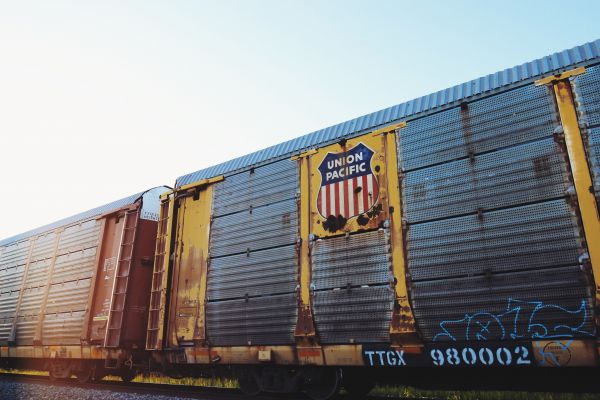Choosing between parcel and freight shipping used to be a (mostly) simple matter of weight—anything weighing less than 150lbs went parcel, and anything heavier than 150lbs went freight. Now, parcel shipping companies like FedEx, UPS, and DHL are capable of shipping items that weigh more than 150lbs, and that means the choice between parcel or freight services isn’t quite so clear.
The key difference between parcel shipping and consolidated freight is the size of the package being shipped. Generally speaking:
- Packages that are shipped through parcel shipping are small and light enough to be lifted without help. They typically weigh under 70lbs but may be heavier as long as they adhere to the carrier’s size restrictions.
- Packages that are shipped by consolidated freight services such as LTL shipping are larger—typically over 150lbs—and are often palletized for additional protection.
If your package falls into the gray area between 70lbs and 150lbs, you’ve got a choice to make. Consider these factors:
- Package density—how much does your package weigh in relation to its size?
- Origin and destination—how far is your cargo travelling?
- Shipment characteristics—is your package fragile or oddly shaped?
- Timing—do you need expedited services?
Keeping these considerations in mind, let’s take a closer look at the differences between parcel shipping and consolidated freight:
Parcel shipping
What is parcel shipping?
Parcel shipping is similar to regular post and is offered by familiar providers such as the United States Postal Service, UPS, FedEx, and DHL.
Key characteristics
- Parcels are typically self-packaged or are packaged by the carrier for an additional fee, and are labelled individually
- Parcels are sorted on conveyor belts and loaded onto shipping trucks and local delivery vans by individuals. They must be small enough to fit in the sorting machines, and light enough to be safely lifted. Typically, parcels weigh less than 70lbs.
Weight and size restrictions
Each parcel shipping carrier has its own size and weight restrictions. Here are the maximum weight, length, and combined length and girth dimensions allowed by three major carriers:
Carrier |
Maximum Weight |
Maximum Length |
Max. Length + Girth |
|---|---|---|---|
USPS® |
170 lbs | 108 inches | 130 inches |
UPS® |
150 lbs | 108 inches | 165 inches |
FedEx® |
150 lbs | 119 inches | 165 inches |
Packages that exceed these restrictions may incur significant surcharges. In these instances, consolidated freight may be a safer, more cost-effective choice.
Advantages |
Disadvantages |
|---|---|
| Cost—parcel shipping may be less expensive due to the larger volume of packages sent using this method | More transfers means there’s a higher risk of parcels getting lost, damaged, or delayed |
|
More checkpoints—package is easier to track |
Some carriers have restrictions on what can and can’t be shipped |
|
|
There may be significant surcharges for items that exceed weight or size restrictions |
How much does parcel shipping cost?
The cost of shipping an item using parcel shipping services depends on four main factors:
- Size
- Weight
- Distance travelled
- Speed
Larger, heavier cargo will incur higher fees. Longer distances, as well as faster delivery, will also cost more, and there may be additional surcharges for items that exceed size and weight requirements.
When to use parcel shipping services
- Small packages weighing less than 150lbs or less than 165 inches in combined length and girth:
HOW TO CALCULATE GIRTH:[ (width x 2) + (height x 2) + length ]
- Packages that weigh more than 150lbs, but are very small (in select cases)
- Tight timelines
Consolidated freight
What is consolidated freight?
When you ship cargo using consolidated freight services such as less-than-truckload (LTL) shipping, your items will share space on the truck with other shipments heading in the same direction. You only pay for the space your items take up on the truck.
Key characteristics
- Items are typically shipped on secured pallets for easy loading and added stability and protection. You can pack them yourself, or have them professionally packed and palletized, depending on the level of service you choose.
- Pallets and other items are commonly moved, loaded, and unloaded using forklifts
- Shipments often travel long distances, which means they may travel from one shipping zone to another without needing to be reloaded along the way. “Zone skipping” may help keep your costs lower than parcel shipping services.
Advantages |
Disadvantages |
|---|---|
| Ideal for larger or oddly-shaped packages and palletized shipments weighing between 200-600lbs | Fewer checkpoints means less up-to-date tracking |
| Fewer checkpoints and transfers—less risk of loss or damage | Can be costlier than parcel shipping |
| Can be used to ship furniture, artwork, antiques, and other high-value items | Longer timelines |
| Security—items are typically transported in special environments designed to prevent damage | May not include packing or loading services |
| Your items are handled by professionals with the specialized skills and experience to handle your cargo safely |
|
How much does consolidated freight cost?
Consolidated freight shipments are priced based on standardized freight classifications. Freight classifications are defined by the National Motor Freight Traffic Association (NMFTA), and are based on four factors:
- Density: The space your cargo occupies in relation to its weight. If there are no special considerations when it comes to stowability, handling, or liability, density will be the most significant factor when assigning a freight class.
- Stowability: The ease or difficulty of loading and carrying your cargo onto and off the truck.
- Handling: Some cargo requires special attention because of its weight, shape, fragility, and other safety hazards.
- Liability: The probability of theft or damage, as well as the likelihood of damage to adjacent freight.
Freight classifications
Learn more about the factors that determine freight class in our Freight Shipping Guide.
Consolidated freight rates are also dependent on what level of service you require. Simple shipments of pre-packed boxes will cost less to ship than items like furniture, antiques, or artwork, which often require professional packing and loading services.
When to use consolidated freight
- Packages over 108 inches in length or weighing over 150 lbs combined
- Oddly-shaped cargo, such as furniture
- Items with special shipping needs, such as antiques or artwork
- When your timeline is flexible
- Volume shipments—if you have several smaller parcels going to the same destination, packing them onto a single pallet can help keep your costs low, and will also be more secure than shipping each item individually using parcel shipping.
Conclusion
If you have items to ship that are too large, heavy, or valuable to transport using parcel shipping services such as FedEx, UPS, or DHL, consolidated freight is a secure alternative.
When you ship your items using consolidated freight, you’ll work with a professional logistics specialist who knows how to transport your cargo safely. Items shipped using parcel shipping services will also be handled by qualified professionals, but because they will be handled more over the course of numerous transfers, there’s a greater risk or loss, delay, or damage.
The best consolidated freight shipping companies will work with you to create a shipping plan that fits your budget and schedule. With over three decades of experience shipping just about anything across the country, TSI has the expertise and flexibility to create a personalized shipping plan that works for you. We can help you move or ship:
- Household goods
- Small moves, including apartments and storage units
- Antiques and heirlooms
- Artwork
- Boxes and crates
- Office equipment
- Estate breakups
- Last minute or emergency shipments
Need help shipping something?
We'll create a personalized shipping plan that works for your household or business shipment.




